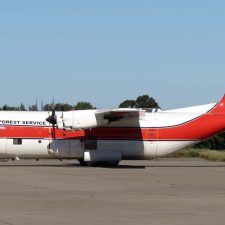Above: Tanker 118 at McClellan Air Field, May 3, 2017. Photo by John Vogel.
This is the first photo we have seen showing U.S. Forest Service Air Tanker 118 with its latest paint job. The USFS plan is to have two of the HC-130H’s at McClellan Air Field at Sacramento (the other is T-116) while the additional five are going through heavy maintenance and retardant tank installation. One is to be actively used as an air tanker while the second is for training, or filling in while the other is down for routine maintenance. As far as I know they are sharing just one of the slip-in MAFFS II retardant delivery units that convert a C-130 into an air tanker. It only takes a few hours to install one of the systems.
The photo below shows T-118 in 2015. Both versions show the crude looking “118” on the tail that detracts from the otherwise very acceptable new paint design. That scheme, approved in 2014, also used the crude font for the number. In addition to flying with the Coast Guard, aircraft #1721 also served with the Air Force and the Navy.

The Air Force, responsible for converting the Coast Guard HC-130H’s into air tankers, has been dithering for years about installing the permanent internal gravity-powered retardant delivery systems in the seven aircraft that are being transferred to the USFS. Most of the ships also need program depot maintenance including new wing boxes. That process began in 2013 when Congress passed the National Defense Authorization Act directing that the Air Force arrange to take care of all of the maintenance and conversion work needed on the planes. Unfortunately, Congress did not give the Air Force a required completion date.
It is interesting that private companies like Aero-Flite, 10 Tanker, Neptune, and Coulson can turn an aircraft into an air tanker in less than a year, but the work on these HC-130H’s is not expected to be complete until the end of this decade, about seven years after it started. And not a single one is finished, four years after it began.
These aircraft that the Coast Guard was happy to unload, are not getting any younger while the Air Force vacillates. Adding another seven years while they are going through the conversions means that Tankers 116 and 118 will be 36 and 32 years old, respectively, in 2020.


Its an awesome program. Taxpayers get a huge savings by using the Coast Guard planes. $122 million in aircraft that don’t need to be purchased. Thats a great start to this program. Govt. In in business to provide services to its citizens at the lowest cost. Not always in business to pay huge costs to private businesses.
L3-Vertex Aerospace is looking for a HC-130H lead mechanic/mechanics. If you know anyone that fits the bill shoot a message.
There are probably some people passionate about the job at the USFS but far away from the decision making …
Its the Forest Service and the Federal Government…did anyone really think this was actually going to work?
It would work if there were people passionate about the job in the positions that run the program.
No surprise here.
Some of us had predicted this scenario.
Operation Knee Jerk. Its over; the private sector has risen to the need and beyond. Leave the retardant delivery to the professions! There are probably numerous Reserve Air Guard units that would like a C 130 just out of I.R.A.N. (Inspect, Repair as needed)
I also think it’s going to be hard to get the crews to staff these platforms at a GS-11/12 level with all the other better paying and better “quality of life” opportunities out there right now in the aviation industry.
There is a picture of T119 on facebook in the Fire Bombers group. this picture depicts the aircraft at Davis-Monthan on or about July 13th. The aircraft in the picture appears to have been placed in storage, the windows are whited out, the props have been removed, doors cover in white, and all holes have been plugged. not sure if the link below will work,
https://www.facebook.com/photo.php?fbid=1810641508951472&set=gm.1829397733742478&type=3&theater
I should mention for those who can’t follow the link or don’t want to. The aircraft is in the final Forest service livery.